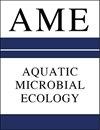Interactions between bacteria and microalgae in microalgal-bacterial symbiotic wastewater treatment systems: mechanisms and influencing factors
IF 1.1
4区 环境科学与生态学
Q3 ECOLOGY
引用次数: 0
Abstract
ABSTRACT: Microalgal-bacterial symbiotic wastewater treatment systems (MBSWTSs) have received widespread attention due to their capacity to achieve high pollutant removal efficiency during wastewater treatment, with low energy consumption requirements, efficient carbon sequestration, and wastewater resource utilization. This paper provides an overview of the treatment performance and current research status of MBSWTSs, including a detailed summary of the mechanisms of nitrogen, phosphorus, and carbon removal by MBSWTSs and the interactions between bacteria and microalgae. In particular, this review focuses on the influence of operational parameters on the regulation of the symbiotic system, such as the microalgal:bacterial ratio, N:P ratio, external carbon source, dissolved oxygen concentration, aeration mode, and light availability. Among these factors, the microalgal:bacterial ratio, carbon source, and light availability have an important influence on microalgal-bacterial competition, as well as the trophic mode of the system, biomass production, and the capacity for the process to be practically applied on a large scale. MBSWTSs still have some challenging aspects that have hindered their development and application, such as the unknown mechanism of microalgal-bacterial co-metabolism, limited previous practical applications, algal contamination, and harvesting difficulties. To overcome these challenges, future research requires a multidisciplinary approach, incorporating life sciences, material science, and other disciplines. Comprehensive research should be conducted on the metabolic mechanisms of MBSWTSs, the optimization of process performance and waste resource utilization, providing a theoretical and practical foundation for the practical application of MBSWTSs.微藻-细菌共生废水处理系统中细菌和微藻之间的相互作用:机制和影响因素
摘要:微藻-细菌共生废水处理系统(MBSWTSs)因其在废水处理过程中能够实现高污染物去除效率、低能耗要求、高效固碳和废水资源化利用而受到广泛关注。本文概述了 MBSWTSs 的处理性能和研究现状,包括对 MBSWTSs 去除氮、磷和碳的机理以及细菌和微藻之间相互作用的详细总结。本综述尤其关注运行参数对共生系统调节的影响,如微藻与细菌的比例、氮磷比、外部碳源、溶解氧浓度、曝气模式和光照可用性。在这些因素中,微藻与细菌的比例、碳源和光照对微藻与细菌的竞争以及系统的营养模式、生物量产量和大规模实际应用的能力都有重要影响。MBSWTS 仍有一些具有挑战性的方面阻碍了其发展和应用,如微藻-细菌协同代谢机制不明、以往的实际应用有限、藻类污染和收获困难等。为了克服这些挑战,未来的研究需要采用多学科方法,将生命科学、材料科学和其他学科结合起来。应全面研究 MBSWTS 的代谢机制、工艺性能优化和废物资源化,为 MBSWTS 的实际应用提供理论和实践基础。
本文章由计算机程序翻译,如有差异,请以英文原文为准。
求助全文
约1分钟内获得全文
求助全文
来源期刊

Aquatic Microbial Ecology
环境科学-海洋与淡水生物学
CiteScore
3.30
自引率
0.00%
发文量
8
审稿时长
3.0 months
期刊介绍:
AME is international and interdisciplinary. It presents rigorously refereed and carefully selected Research Articles, Reviews and Notes, as well as Comments/Reply Comments (for details see AME 27:209), Opinion Pieces (previously called ''As I See It'') and AME Specials. For details consult the Guidelines for Authors. Papers may be concerned with:
Tolerances and responses of microorganisms to variations in abiotic and biotic components of their environment; microbial life under extreme environmental conditions (climate, temperature, pressure, osmolarity, redox, etc.).
Role of aquatic microorganisms in the production, transformation and decomposition of organic matter; flow patterns of energy and matter as these pass through microorganisms; population dynamics; trophic interrelationships; modelling, both theoretical and via computer simulation, of individual microorganisms and microbial populations; biodiversity.
Absorption and transformation of inorganic material; synthesis and transformation of organic material (autotrophic and heterotrophic); non-genetic and genetic adaptation; behaviour; molecular microbial ecology; symbioses.
 求助内容:
求助内容: 应助结果提醒方式:
应助结果提醒方式:


